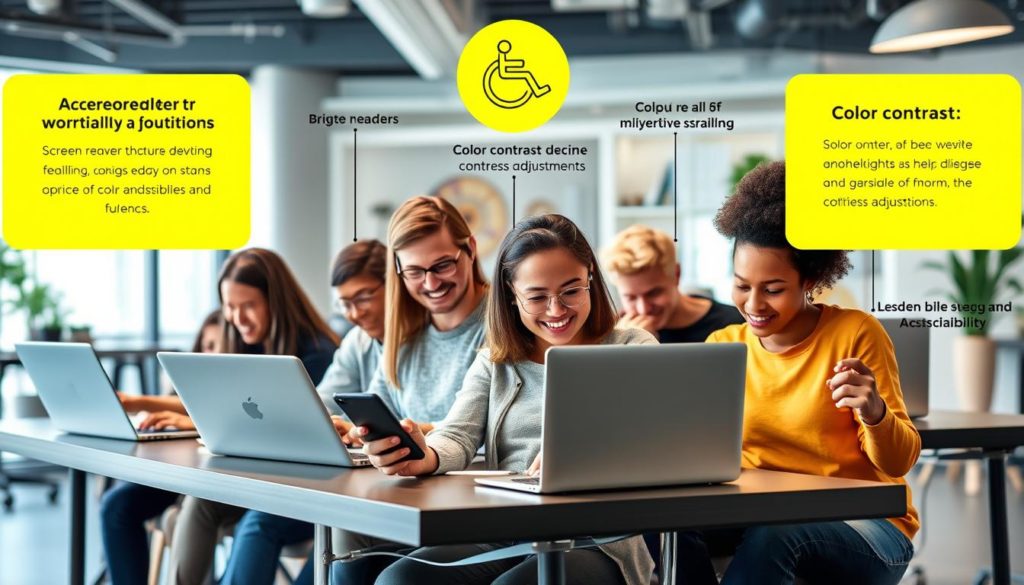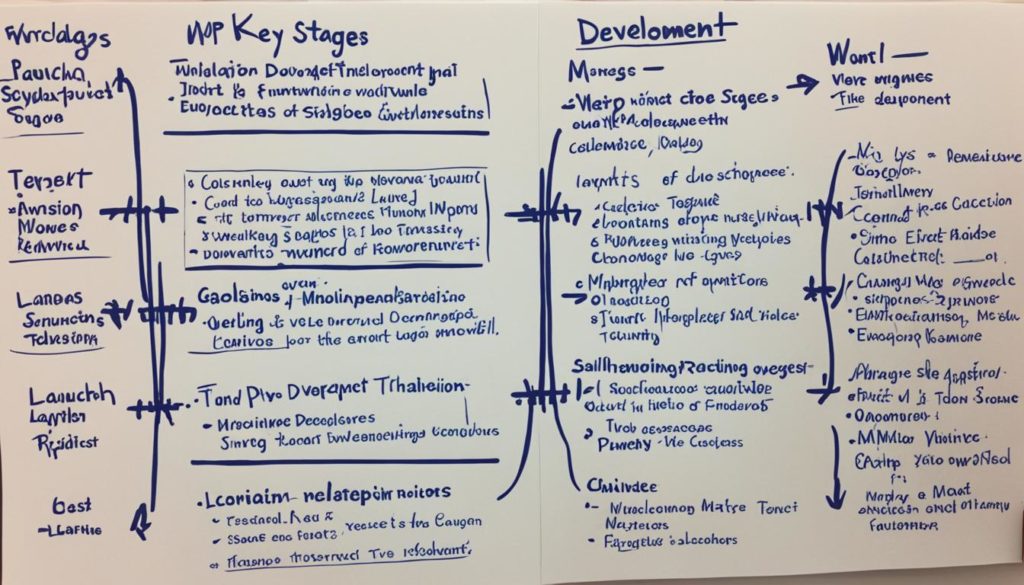
Did you know that a staggering 96.3% of the top million homepages did not comply with ADA standards in 2023? This shocking fact shows a big problem: many websites don’t meet basic web accessibility rules. In today’s world, making websites accessible is key. It’s not just about avoiding legal trouble, but also about welcoming more people.
The U.S. Census Bureau says there are about 61 million individuals with disabilities and 71 million Baby Boomers in the U.S. Together, they have $548 billion to spend. This shows how important it is to make websites accessible to everyone.
It’s vital to understand the need for accessible websites. The Americans with Disabilities Act (ADA) and Section 508 of the Rehabilitation Act have strict rules for digital platforms. The Web Content Accessibility Guidelines (WCAG) by the World Wide Web Consortium (W3C) provide a detailed guide for making websites accessible. Following these guidelines helps avoid legal issues, improves your brand’s image, and makes your website better for users.
Automated tools can only find about 30% of accessibility problems. That’s why checking websites manually is essential. Not following these rules can cost a lot, with fines and settlements ranging from $5K to $20K. The first offense can even cost up to $75,000.
Key Takeaways
- 96.3% of top websites failed to meet ADA standards in 2023, highlighting a widespread issue.
- WCAG serves as the backbone of digital accessibility standards and legal compliance.
- Human testing is critical as automated tools can only detect 30% of WCAG issues.
- Non-compliance can lead to costly legal repercussions, including fines and settlements.
- An inclusive web design enriches user experience and broadens your audience reach.
Understanding Web Accessibility Compliance
Web accessibility compliance means making websites easy for everyone to use. People with disabilities use special tools like screen readers and voice recognition software. Making websites accessible is not just the law; it helps everyone communicate better.
More services are moving online, making web accessibility key. Common problems include bad color contrast and missing text on images. Following WCAG guidelines and Section 508 Standards helps fix these issues.
The ADA rules apply to government websites and businesses open to the public. This includes online services like voting and paying fines. Businesses like stores and banks must follow these rules too.
The Department of Justice enforces web accessibility through agreements with various groups. The main standards are WCAG 2.0 or 2.1 at Level AA. Tools like accessScan help check if websites are accessible.
To fix web accessibility issues, add alt text to images and adjust colors. Make sure videos have captions and websites work well with keyboards and screen readers. Tools like accessWidget can automatically make code changes.
Website owners must keep checking their sites to follow changing rules. Websites must have an accessibility statement, often in the footer or with widgets like accessWidget.
Key Principles of Web Content Accessibility Guidelines (WCAG)
The Web Content Accessibility Guidelines (WCAG) are based on four main principles. These are known as the POUR principles: Perceivable, Operable, Understandable, and Robust. They help make the internet accessible to everyone, including the 61 million adults in the U.S. with disabilities.
Perceivable
The “Perceivable” guideline is a key part of the POUR principles. It says that all information and user interface parts must be clear to everyone. This means having text for non-text content and good color contrast. Following these rules can make users happier and more engaged, as studies have shown.
About 71% of people with disabilities have trouble getting to content. This principle tries to fix that problem.
Operable
The “Operable” principle makes sure everyone can use the website. It means all parts must work with a keyboard and give users enough time to read and use the content. These steps can make users stick around longer and use the site more easily.
Understandable
The “Understandable” principle says information and how the site works must be easy to get. This means text should be clear and predictable, and users should be able to fix mistakes easily. This makes using the site smooth and fun, which can lead to more sales and a bigger audience.
Robust
The “Robust” principle ensures content works well with many tools, including those for people with disabilities. It encourages using standards to keep the site working well over time. Following these rules can make users happier and more likely to come back.
Understanding and using the Web Content Accessibility Guidelines is very important. It makes the internet better for everyone. These rules help websites be legal and make users happy and loyal, showing how important accessible web design is.
| Principle | Description | Impact |
|---|---|---|
| Perceivable | Information must be presented in ways that users can perceive, including text alternatives and proper color contrast. | Increases user engagement and satisfaction by making content accessible to all. |
| Operable | User interfaces must be navigable and usable by everyone, including those requiring keyboard accessibility. | Improves user retention rates and usability metrics. |
| Understandable | Information and the operation of the user interface must be easy to understand. | Enhances user satisfaction and increases market reach. |
| Robust | Content must be reliably interpreted by various user agents, including assistive technologies. | Boosts user retention and ensures compatibility across platforms. |
The Importance of ADA Compliance for Websites
In today’s digital world, making sure websites follow ADA rules is key. The Americans with Disabilities Act (ADA) from 1990 requires equal access online. Not following these rules can hurt a business’s reputation and lead to big fines and legal trouble.
Legal Obligations
ADA rules mean businesses must not discriminate against people with disabilities. In the U.S., sites of companies with 15 or more employees must meet ADA standards. The Department of Justice enforces these rules and has seen more lawsuits against non-compliant sites. WCAG guidelines are the standard for making websites accessible to everyone.
Places like schools, government offices, and stores must follow ADA rules. But, some like churches and small businesses with less than 15 employees are not required. Still, making your website accessible is good for everyone and shows you care about your customers.
Financial Consequences of Non-Compliance
Not following ADA rules can cost a lot. The Department of Justice can fine up to $150,000 for repeated offenses. This can really hurt a business’s finances. Making your website accessible can also help your business grow by attracting more customers.
The IRS offers tax credits for businesses that make their sites ADA-compliant. This helps businesses avoid legal problems and fines. The Department of Justice says following ADA rules is important for fairness and a better user experience. For more on ADA website compliance, check out the Web Content Accessibility Guidelines.
Section 508 Compliance: What You Need to Know
Section 508 compliance is key for making Electronic and Information Technology (EIT) accessible to people with disabilities. It’s part of the Rehabilitation Act of 1973. This law requires federal agencies to make their EIT accessible to all, including those with disabilities.
In 2017, the law was updated to match the Web Content Accessibility Guidelines (WCAG), Levels A and AA. This ensures that digital content is available to everyone.
Not following Section 508 can cause big problems. You might face financial penalties, damage to your reputation, and legal issues. For federal organizations, following these rules is more than just following the law. It’s about being inclusive.
According to the Section 508 standards, EIT must be easy to see, use, understand, and work well. This makes sure digital content is open to everyone.
The following table provides a summary of essential legislation related to accessibility:
| Legislation | Year Enacted | Purpose |
|---|---|---|
| Rehabilitation Act of 1973 | 1973 | Mandates federal agencies to make EIT accessible. |
| Americans with Disabilities Act (ADA) | 1990 | Ensures equal opportunities for individuals with disabilities. |
| 21st Century Communications and Video Accessibility Act | 2010 | Makes advanced communication services and products accessible. |
| 21st Century IDEA | 2018 | Mandates the modernization of websites and digital services. |
It’s important to always check if you’re following Section 508 rules. Making EIT accessible helps everyone. It makes your environment more inclusive and avoids big problems if you don’t follow the rules.
Conducting an Accessibility Audit: Checklist and Tools
Doing an accessibility audit is key to making your website welcoming to everyone. It checks if your site, apps, and mobile apps meet accessibility standards.
Recommended Accessibility Testing Tools
Automated tools are great for spotting common problems quickly. Here are some top tools:
- WAVE Browser Extension
- WAVE Standalone API
- Markup Validation Service
- W3C Validator tools
These tools find issues like missing text and wrong heading use. But, it’s also important to do manual checks. Equalize Digital says automated tests only find 30-50% of problems, so manual checks are crucial.
World Health Organization says 1 in 6 people have big disabilities. So, it’s important to have experts do audits. Harvard and MIT faced legal trouble for not having captions for deaf people. Regular checks can avoid such big problems.
Steps in an Accessibility Audit
Creating a detailed checklist is the first step. Here’s what to do:
- Define Testing Criteria: Use WCAG guidelines, aiming for at least WCAG 2.0 AA. More on WCAG is here.
- Conduct User Testing: Get feedback from people with disabilities for a better experience.
- Review Navigation: Make sure your site is easy to navigate with screen readers and keyboards.
- Content Understandability: Make sure all content is easy to understand, with alternatives for images and videos.
- Generate Reports: Write a detailed report of your findings and suggest fixes.
- Prioritize and Act: Fix the most important problems first, based on how they affect users.
- Regular Monitoring: Keep checking your site regularly to keep it accessible. This saves time and avoids legal trouble.
In short, following an accessibility checklist and using both automated and manual tools is essential. Regular audits and updates to WCAG standards keep your site inclusive and legal.
Inclusive Web Design Best Practices
Inclusive web design is very important. It makes sure our websites are easy for everyone to use. This includes people with disabilities and those using different devices. Let’s look at some key parts of making a website inclusive.
User-Friendly Navigation
Navigation that’s easy to use is key for accessibility. It helps users find and interact with content without trouble. Google suggests using a 16px font size for better reading.
The WCAG guidelines also say text should be resizable up to 200% and have a contrast ratio of at least 4.5:1. This makes the site easy for everyone to use.
Responsive Design
Responsive design is crucial for inclusive web design. It makes sure websites work well on all devices and screen sizes. This makes browsing better for everyone, no matter what device they use.
Using fluid grids, flexible images, and media queries helps a lot. It’s also important to make sure the site is easy to use with a keyboard and works with assistive technology.
Accessible Content Creation
Creating content that’s easy for everyone to understand is important. This means adding alt text for images and making sure interactive parts are easy to use with a keyboard. The WCAG says it’s important to avoid flashing content to prevent seizures.
It’s also good to provide text transcripts for audio-video content. Captions for audio and video, and descriptions for video, help blind users. This makes sure everyone can access the information.
By following inclusive web design practices, we meet important rules like the ADA and WCAG. We also make our website friendly for everyone. This shows we care about inclusivity and helps our online presence.
FAQ
What is web accessibility compliance?
Web accessibility compliance makes sure everyone can use websites. It follows rules like the Web Content Accessibility Guidelines (WCAG) and laws like the ADA and Section 508.
Why is web accessibility compliance important?
It’s key for a website to be open to all. It lets more people use the web, including those with disabilities. It also keeps your site safe from legal trouble and fines.
What are the key principles of the WCAG?
WCAG has four main rules: Perceivable, Operable, Understandable, and Robust. These ensure websites are easy for everyone to use, including those with disabilities.
How do ADA regulations impact web accessibility?
The ADA says websites must be open to people with disabilities. It uses WCAG as a guide. Not following these rules can cost a lot and hurt your reputation.
What is Section 508 compliance?
Section 508 is for U.S. federal agencies. It makes sure their digital stuff is accessible. This means following WCAG, especially Levels A and AA, to make content open to all.
What tools are recommended for an accessibility audit?
Good tools for checking websites include the WAVE Browser Extension and the W3C Validator. They find problems that make websites hard to use.
What are the steps involved in an accessibility audit?
First, set up tests based on WCAG. Then, get feedback from people with disabilities. Check how easy it is to navigate and understand the content. Finally, make a report with steps to make the site more inclusive.
What are some best practices for inclusive web design?
For inclusive design, make navigation easy and use responsive design. Use clear language and provide text for images. Make sure it works well with keyboards and assistive technology.
Future App Studios is an award-winning software development & outsourcing company. Our team of experts is ready to craft the solution your company needs.










